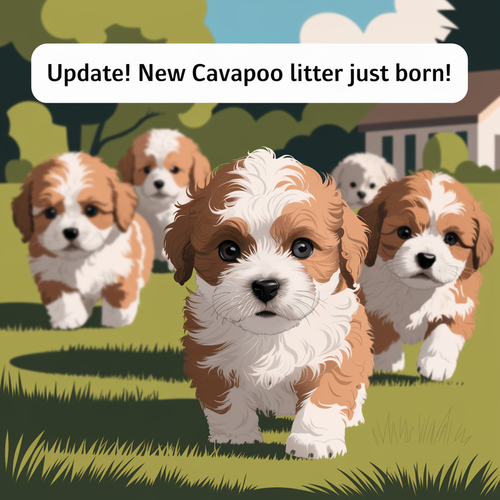
Why Nail Trimming is Essential
Trimming your dog’s nails is an important part of their overall health and comfort. Just like us, dogs need regular grooming to stay healthy and happy, and nail care is a big part of that. Overgrown nails can cause discomfort, pain, and even lead to more serious issues like infections or difficulty walking. However, many dog owners are unsure of how often they should be trimming their dog’s nails.
The answer isn’t one-size-fits-all. Several factors can influence how often your dog’s nails need to be trimmed, including their diet, activity level, and even their breed. As a small family breeder in Missouri, we’ve had years of experience raising healthy, well-groomed puppies, and we’re here to share our insights with you. Whether you’re a new dog owner or looking to improve your grooming routine, understanding these factors will help you keep your dog’s nails in top shape.

Factors Influencing Nail Growth
Diet and Nutrition
What your dog eats plays a significant role in their overall health, including how quickly their nails grow. Certain ingredients in dog food can either speed up or slow down nail growth. For instance, high-quality dog foods rich in essential vitamins and minerals support healthy nail growth. On the other hand, some dogs may experience faster nail growth due to certain proteins or supplements in their diet.
If you’ve noticed that your dog’s nails grow unusually fast or slow, it might be worth taking a closer look at their diet. Ensuring they’re eating a balanced, nutritious diet can help regulate nail growth and make grooming easier. It’s just one more reason why what you feed your dog matters so much to their overall well-being.
For more on how diet impacts your dog’s health and behaviors, check out our article on Why Does My Dog Eat Poop? Common Solutions to This Unappetizing Problem.
Surface and Activity Level
The type of surfaces your dog frequently walks or runs on can greatly influence how often their nails need to be trimmed. Dogs that spend a lot of time on hard surfaces like concrete or asphalt tend to wear down their nails naturally, reducing the need for frequent trimming. Similarly, dogs that dig or scratch a lot also wear down their nails on their own, meaning they may not need trimming as often.
Conversely, if your dog spends most of their time indoors on soft surfaces like carpet or grass, their nails won’t wear down as quickly. This means you’ll likely need to trim their nails more frequently to prevent them from getting too long.
Understanding how your dog’s activity level and environment affect their nail growth can help you determine the best grooming schedule for them. For additional tips on adjusting to your dog’s lifestyle, read our guide on Helping Your Dog Adjust to a New Home.
Breed and Size Considerations
The breed and size of your dog also play a crucial role in how often their nails need to be trimmed. Smaller breeds often have faster-growing nails, which means they may need more frequent trims. Conversely, larger breeds, especially those that are very active, might wear down their nails more naturally and may not require trimming as often.
Certain breeds, like Greyhounds or Whippets, tend to have slower-growing nails, while others, like Dachshunds or Beagles, might see faster nail growth due to their genetic makeup. It’s important to know your dog’s breed-specific needs to ensure their nails are kept at a healthy length.
Being aware of these factors can help you establish a nail-trimming routine that’s perfectly suited to your dog’s unique needs.
How Often Should You Trim Your Dog’s Nails?
General Guidelines
When it comes to trimming your dog’s nails, the frequency can vary widely depending on the factors we’ve discussed. However, a general guideline is to check your dog’s nails every 1 to 4 months. For some dogs, especially those that are very active or spend a lot of time on hard surfaces, trimming may only be necessary every few months. For others, particularly smaller breeds or those who spend most of their time indoors, nail trimming may need to be done more frequently, perhaps every month.
A good rule of thumb is to listen for the sound of your dog’s nails clicking on hard floors. If you hear clicking, it’s likely time for a trim. You can also visually inspect the nails to see if they are starting to curl or if they’re getting too close to the paw pads. Keeping the nails short enough to avoid discomfort while allowing them to naturally wear down through activity is the key.
Specific Scenarios
In some cases, your dog’s nails may require more or less frequent trimming:
-
When to Trim More Often:
If your dog spends most of their time indoors on soft surfaces or is a smaller breed with fast-growing nails, you may need to trim their nails more frequently. Indoor dogs generally don’t wear their nails down naturally, so they’ll require regular trimming to prevent overgrowth. -
When to Trim Less Often:
Dogs that are very active outdoors, especially on hard surfaces, or those that dig frequently, may need less frequent trims. Their nails naturally wear down through these activities, reducing the need for regular trimming. However, it’s still important to check their nails regularly to ensure they aren’t getting too long.
Understanding your dog’s unique needs will help you maintain a regular nail-trimming schedule that keeps them comfortable and healthy.
Tips for Safe and Effective Nail Trimming
- Start by gently holding your dog’s paw and isolating the nail you plan to trim.
- Identify the quick, which is the pink area inside the nail that contains nerves and blood vessels. Avoid cutting into the quick, as it will cause pain and bleeding. For dogs with dark nails, it’s harder to see the quick, so it’s best to trim small amounts gradually.
- Cut at a slight angle and trim only a small portion of the nail at a time. It’s better to trim a little bit and come back later if needed than to risk cutting too much.











